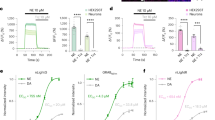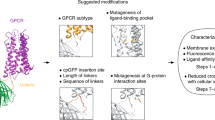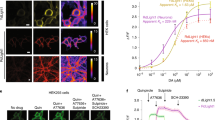Abstract
Dopamine neuromodulation of neural synapses is a process implicated in a number of critical brain functions and diseases. Development of protocols to visualize this dynamic neurochemical process is essential to understanding how dopamine modulates brain function. We have developed a non-genetically encoded, near-IR (nIR) catecholamine nanosensor (nIRCat) capable of identifying ~2-µm dopamine release hotspots in dorsal striatal brain slices. nIRCat is readily synthesized through sonication of single walled carbon nanotubes with DNA oligos, can be readily introduced into both genetically tractable and intractable organisms and is compatible with a number of dopamine receptor agonists and antagonists. Here we describe the synthesis, characterization and implementation of nIRCat in acute mouse brain slices. We demonstrate how nIRCat can be used to image electrically or optogenetically stimulated dopamine release, and how these procedures can be leveraged to study the effects of dopamine receptor pharmacology. In addition, we provide suggestions for building or adapting wide-field microscopy to be compatible with nIRCat nIR fluorescence imaging. We discuss strategies for analyzing nIR video data to identify dopamine release hotspots and quantify their kinetics. This protocol can be adapted and implemented for imaging other neuromodulators by using probes of this class and can be used in a broad range of species without genetic manipulation. The synthesis and characterization protocols for nIRCat take ~5 h, and the preparation and fluorescence imaging of live brain slices by using nIRCats require ~6 h.
This is a preview of subscription content, access via your institution
Access options
Access Nature and 54 other Nature Portfolio journals
Get Nature+, our best-value online-access subscription
$29.99 / 30 days
cancel any time
Subscribe to this journal
Receive 12 print issues and online access
$259.00 per year
only $21.58 per issue
Buy this article
- Purchase on Springer Link
- Instant access to full article PDF
Prices may be subject to local taxes which are calculated during checkout





Similar content being viewed by others
Data availability
All materials are available from commercial sources or can be derived by using methods described in this protocol. All primary data underlying the figures reported in the article are publicly available via the Dryad repository at https://doi.org/10.6078/D1VH87. Additional data can be obtained from the corresponding author upon reasonable request.
Code availability
Code for analyzing and processing nIR images is freely available online at https://github.com/jtdbod/Nanosensor-Imaging-App and released under an MIT license.
References
Cohen, J. Y., Haesler, S., Vong, L., Lowell, B. B. & Uchida, N. Neuron-type-specific signals for reward and punishment in the ventral tegmental area. Nature 482, 85–88 (2012).
Double, K. L. & Crocker, A. D. Dopamine receptors in the substantia nigra are involved in the regulation of muscle tone. Proc. Natl. Acad. Sci. USA 92, 1669–1673 (1995).
Berke, J. D. What does dopamine mean? Nat. Neurosci. 21, 787–793 (2018).
Dudman, J. T. & Krakauer, J. W. The basal ganglia: from motor commands to the control of vigor. Curr. Opin. Neurobiol. 37, 158–166 (2016).
Lebowitz, J. J. & Khoshbouei, H. Heterogeneity of dopamine release sites in health and degeneration. Neurobiol. Dis. 134, 104633 (2020).
Bibb, J. A. et al. Severe deficiencies in dopamine signaling in presymptomatic Huntington’s disease mice. Proc. Natl. Acad. Sci. USA 97, 6809–6814 (2000).
Weinstein, J. J. et al. Pathway-specific dopamine abnormalities in schizophrenia. Biol. Psychiatry. 81, 31–42 (2017).
Greengard, P. The neurobiology of slow synaptic transmission. Science 294, 1024–1030 (2001).
Rice, M. E. & Cragg, S. J. Dopamine spillover after quantal release: rethinking dopamine transmission in the nigrostriatal pathway. Brain Res. Rev. 58,, 303–313 (2008).
Zoli, M. et al. The emergence of the volume transmission concept. Brain Res. Rev. 26, 136–147 (1998).
Beyene, A. G., McFarlane, I. R., Pinals, R. L. & Landry, M. P. Stochastic simulation of dopamine neuromodulation for implementation of fluorescent neurochemical probes in the striatal extracellular space. ACS Chem. Neurosci. 8, 2275–2289 (2017).
Beyene, A. G., Yang, S. J. & Landry, M. P. Review article: tools and trends for probing brain neurochemistry. J. Vac. Sci. Technol. A 37, 040802 (2019).
Chefer, V. I., Thompson, A. C., Zapata, A. & Shippenberg, T. S. Overview of brain microdialysis. Curr. Protoc. Neurosci. Chapter 7, Unit 7.1 (2009).
Nakatsuka, N. & Andrews, A. M. Differentiating siblings: the case of dopamine and norepinephrine. ACS Chem. Neurosci. 8, 218–220 (2017).
Ngo, K. T., Varner, E. L., Michael, A. C. & Weber, S. G. Monitoring dopamine responses to potassium ion and nomifensine by in vivo microdialysis with online liquid chromatography at one-minute resolution. ACS Chem. Neurosci. 8, 329–338 (2017).
Sames, D., Dunn, M., Karpowicz, R. J. & Sulzer, D. Visualizing neurotransmitter secretion at individual synapses. ACS Chem. Neurosci. 4, 648–651 (2013).
Patriarchi, T. et al. Ultrafast neuronal imaging of dopamine dynamics with designed genetically encoded sensors. Science 360, eaat4422 (2018).
Sun, F. et al. A genetically encoded fluorescent sensor enables rapid and specific detection of dopamine in flies, fish, and mice. Cell 174, 481–496.e19 (2018).
Beyene, A. G. et al. Imaging striatal dopamine release using a nongenetically encoded near infrared fluorescent catecholamine nanosensor. Sci. Adv. 5, eaaw3108 (2019).
Hong, G. et al. Through-skull fluorescence imaging of the brain in a new near-infrared window. Nat. Photonics 8, 723–730 (2014).
O’Connell, M. J. et al. Band gap fluorescence from individual single-walled carbon nanotubes. Science 297, 593–596 (2002).
Beyene, A. G. et al. Ultralarge modulation of fluorescence by neuromodulators in carbon nanotubes functionalized with self-assembled oligonucleotide rings. Nano Lett. 18, 6995–7003 (2018).
Jeong, S. et al. High-throughput evolution of near-infrared serotonin nanosensors. Sci. Adv. 5, 3771–3789 (2019).
Li, C. & Wang, Q. Challenges and opportunities for intravital near-infrared fluorescence imaging technology in the second transparency window. ACS Nano 12, 9654–9659 (2018).
Kruss, S. et al. High-resolution imaging of cellular dopamine efflux using a fluorescent nanosensor array. Proc. Natl. Acad. Sci. USA 114, 1789–1794 (2017).
Dinarvand, M. et al. Near-infrared imaging of serotonin release from cells with fluorescent nanosensors. Nano Lett 19, 6604–6611 (2019).
Del Bonis-O’Donnel, J. T. et al. Engineering molecular recognition with bio-mimetic polymers on single walled carbon nanotubes. J. Vis. Exp. 119, 55030 (2017).
Zhang, J. et al. Molecular recognition using corona phase complexes made of synthetic polymers adsorbed on carbon nanotubes. Nat. Nanotechnol. 8, 959–968 (2013).
Boyden, E. S., Zhang, F., Bamberg, E., Nagel, G. & Deisseroth, K. Millisecond-timescale, genetically targeted optical control of neural activity. Nat. Neurosci. 8, 1263–1268 (2005).
Kida, H., Sakimoto, Y. & Mitsushima, D. Slice patch clamp technique for analyzing learning-induced plasticity. J. Vis. Exp. 129, 55876 (2017).
Geiger, B. M., Frank, L. E., Caldera-Siu, A. D. & Pothos, E. N. Survivable stereotaxic surgery in rodents. J. Vis. Exp. 20, 880 (2008).
Romano, S. A. et al. An integrated calcium imaging processing toolbox for the analysis of neuronal population dynamics. PLoS Comput. Biol. 13, e1005526 (2017).
Pnevmatikakis, E. A. et al. Simultaneous denoising, deconvolution, and demixing of calcium imaging data. Neuron 89, 285–299 (2016).
Jeng, E. S.-H. The Investigation of Interactions between Single Walled Carbon Nanotubes and Flexible Chain Molecules. Thesis, Massachusetts Institute of Technology (2010).
Schneider, C. A., Rasband, W. S. & Eliceiri, K. W. NIH Image to ImageJ: 25 years of image analysis. Nat. Methods 9,, 671–675 (2012).
Schindelin, J. et al. Fiji: an open-source platform for biological-image analysis. Nat. Methods 9,, 676–682 (2012).
Van Der Walt, S. et al. scikit-image: image processing in Python. PeerJ 2, e453 (2014).
Otsu, N. Threshold selection method from gray-level histograms. IEEE Trans. Syst. Man Cybern. SMC-9, 62–66 (1979).
Sorensen, J., Wiklendt, L., Hibberd, T., Costa, M. & Spencer, N. J. Techniques to identify and temporally correlate calcium transients between multiple regions of interest in vertebrate neural circuits. J. Neurophysiol. 117, 885–902 (2017).
Acknowledgements
The authors acknowledge prior work from A.G.B. presented in this protocol and previously published by Beyene et al.19. We acknowledge support of NIH MIRA award R35 (to M.P.L.), a Burroughs Wellcome Fund Career Award at the Scientific Interface (CASI) (to M.P.L.), the Simons Foundation (to M.P.L.), a Stanley Fahn PDF Junior Faculty Grant with Award No. PF-JFA-1760 (to M.P.L.), a Beckman Foundation Young Investigator Award (to M.P.L.), a CZI Deep-Tissue Imaging Award (to M.P.L.) and a DARPA Young Investigator Award (to M.P.L.). M.P.L. is a Chan Zuckerberg Biohub investigator. S.J.Y. acknowledges the support of NSF Graduate Research Fellowships (NSF DGE 1752814). J.T.D.B.-O. is supported by the Department of Defense office of the Congressionally Directed Medical Research Programs (CDMRP) Parkinson’s Research Program (PRP) Early Investigator Award.
Author information
Authors and Affiliations
Contributions
A.G.B. and M.P.L. designed the experiments. J.T.D.B.-O. designed and built the microscope system and wrote the analysis software package. A.G.B., S.J.Y. and J.T.D.B.-O. performed the experiments. A.G.B., S.J.Y. and J.T.D.B.-O. analyzed the data and created the figures. S.J.Y. and J.T.D.B.-O. wrote the manuscript. All authors approved the manuscript.
Corresponding author
Ethics declarations
Competing interests
The authors declare no competing interests.
Additional information
Peer review information Nature Protocols thanks the anonymous reviewers for their contribution to the peer review of this work.
Publisher’s note Springer Nature remains neutral with regard to jurisdictional claims in published maps and institutional affiliations.
Related links
Key references using this protocol
Beyene, A. G. et al. Sci. Adv. 5, eaaw3108 (2019): https://doi.org/10.1126/sciadv.aaw3108
Jeong, S. et al. Sci. Adv. 5, 3771–3789 (2019): https://doi.org/10.1126/sciadv.aay3771
Yang, D. et al. ACS Nano. 14, 13794–13805 (2020): https://doi.org/10.1021/acsnano.0c06154
Beyene, A. G. et al. Nano Lett. 18, 6995–7003 (2018): https://doi.org/10.1021/acs.nanolett.8b02937
Supplementary information
Supplementary Video 1
Supplementary Video 1
Supplementary Video 2
Supplementary Video 2
Rights and permissions
About this article
Cite this article
Yang, S.J., Del Bonis-O’Donnell, J.T., Beyene, A.G. et al. Near-infrared catecholamine nanosensors for high spatiotemporal dopamine imaging. Nat Protoc 16, 3026–3048 (2021). https://doi.org/10.1038/s41596-021-00530-4
Received:
Accepted:
Published:
Issue Date:
DOI: https://doi.org/10.1038/s41596-021-00530-4
This article is cited by
-
Near-infrared II fluorescence imaging
Nature Reviews Methods Primers (2024)
Comments
By submitting a comment you agree to abide by our Terms and Community Guidelines. If you find something abusive or that does not comply with our terms or guidelines please flag it as inappropriate.



